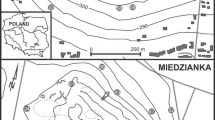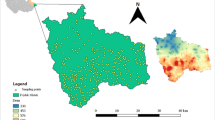Abstract
Analyses of contaminant concentrations in soils are frequently carried out in urban regions because soils can act as both a sink and a secondary source of contaminants to the environment. Total soil concentration data are required to evaluate soil quality and the ability of soils to support life, however to determine the source and dispersion of contaminants and an accurate depiction of spatial distributions, normalised data are required. The effectiveness and economics of three normalisation methods for soils are tested in the current study. Size normalisation undertaken by physical separation of the fine fraction (<62.5 μm) provides consistent spatial information, but is time consuming and expensive and does not capture anthropogenic contributions associated with the coarse fraction of the soil, which is not generally analysed. Elemental normalisation only utilises a single analysis of the total soil, but requires that the normalising element acts conservatively, and as a proxy for the fine fraction, which are requirements not always met. A new post-extraction normalising procedure (PEN) also requires an analysis of the total soil only, but is not dependent on a normalising element and can be used to normalise any type of contaminant. In this approach, the residue after acid digestion is assumed to be the major diluent controlling the confounding effects of variable grain size. A strong relationship between the residue mass and soil size supports the use of this residue material as a normalising agent. Results indicate that the PEN method is equally efficient at reducing the confounding effects of variable grain size as elemental normalisation, but that size normalisation produces the most consistent spatial information and should be used in detailed studies of source and dispersion.
Similar content being viewed by others
References
Albasel, N. and Cottenie, A.: 1985, ‘Heavy metal contamination near major highways, industrial and urban areas in Belgian grassland’, Water Air Soil Pollut. 24, 103-109.
Alexandrovskaya, E. I. and Alexandrovskiy, A. L.: 2000, ‘History of the cultural layer in Moscow and accumulation of anthropogenic substances in it’, Catena 41, 249-259.
Barbanti, A. and Bothner, M. H.: 1993, ‘A procedure for partitioning bulk sediments into distinct grain-size fractions for geochemical analysis’, Environ. Geol. 21, 3-13.
Birch, G. F. and Taylor, S. E.: 1999, ‘Source of heavy metals in sediments of Port Jackson Estuary, Australia’, Sci. Total Environ. 27, 123-138.
Birch, G. F. and Taylor, S. E.: 2000, ‘The use of size-normalisation procedures in the analysis of organic contaminants in estuarine environments’, Hydrobiologia 431, 129-133.
Birch, G. F.: 2003, ‘A test of normalisation methods for marine sediments, including a new Post-Extraction Normalisation (PEN) technique’, Hydrobiologia 492, 5-13.
Brook, E. J. and Moore, J. N.: 1988, ‘Particle-size and chemical control of As, Cd, Cu, Fe, Mn, Ni, Pb, and Zn in bed Sediment from the Clark Fork River, Montana (U.S.A.)’, Sci. Total Environ. 76, 247-266.
Bubb, J. M., Rudd, T. and Lester, J. N.: 1991, ‘Distribution of heavy metals in the River Yare and its associated broads. III. Lead and zinc’, Sci. Total Environ. 102, 89-208.
Clark, M. W., Davis-McConchie, F., McConchie, D. and Birch, G. F.: 2000, ‘Selective chemical extraction and grain size normalisation for environmental assessment of anoxic sediments: validation of an integrated procedure’, Sci. Total Environ. 258, 149-170.
Culbard, E. B., Thornton, I., Wheatley, M., Moorcroft, S. and Thompson, M.: 1988, ‘Metal contamination in British urban dusts and soils’, J. Environ. Qual. 17/ 2, 226-234.
Daskalakis, K. D. and O'Connor, T. P.: 1995, ‘Normalization and elemental sediment contamination in the coastal United States’, Environ. Sci. Technol. 9, 470-477.
Forstner, U. and Wittmann, G. T. W.: 1979, Metal Pollution in the Aquatic Environment, Springer-Verlag, New York.
Ge, Y., Murray, P. and Hendershot, W. H.: 2000, ‘Trace metal speciation and bioavailability in urban soils’, Environ. Pollut. 107, 137-144.
Grant, A. and Middleton, R.: 1990, ‘An assessment of metal contamination of sediments in the Humber Estuary, U.K.’, Estuarine Coastal Shelf Sci. 31, 71-85.
Komai, Y.: 1981, ‘Heavy metal contamination in urban soils. II. Comparison of urban park soils between two Cities with different city and industrial activities’, Bull. Univ. Osaka Pref., Ser. B 33, 13-22.
Krumgalz, B. S., Fainshtein, G. and Cohen, A.: 1992, ‘Grain size effect on anthropogenic trace metal and organic matter distribution in marine sediments’, Sci. Total Environ. 116, 15-30.
Loring, D. H.: 1991, ‘Normalisation of heavy-metal data from estuarine and coastal sediments’, J. Mar. Sci. 48, 101-115.
Loring, D. H. and Rantala, T. T.: 1992, ‘Manual for the geochemical analyses of marine sediments and suspended particulate matter’, Earth-Sci. Rev. 32, 235-83.
Markus, J. and McBratney, A. B.: 2001, ‘An urban soil survey: heavy metals in Glebe, Australia’, Environ. Int. 27, 399-411.
Mielke, H. W., Gonzales, C. R., Smith, M. K. and Mielke, P. W.: 2000, ‘Quantities and associations of lead, zinc, cadmium, manganese, chromium, nickel, vanadium, and copper in fresh Mississippi Delta alluvium and New Orleans alluvial soils’, Sci. Total Environ. 246, 249-259.
Mielke, H. W., Wang, G., Gonzales, C. R., Le, B., Quach, V. N. and Mielke, P. W.: 2001, ‘PAH and Metal mixtures in New Orlean soils and sediments’, Sci. Total Environ. 281, 217-227.
Reimann, C., Siewers, U., Tarvainen, T., Bityukova, L., Ericksson, J., Gilucis, A., Gregorauskiene, V., Lukashev, V., Matinian, N. N. and Pasieczna, A.: 2000, ‘Baltic Soil Survey: Total concentrations of major and selected trace elements in arable soils from 10 countries around the Baltic Sea’, Sci. Total Environ. 257/ 2-3, 155-170.
Sakai, H., Kojima, Y. and Saito, K.: 1986, ‘Distribution of heavy metals in water and sieved sediment in the Toyohira River’, Water Res. 20, 559-567.
Snowdon, R. T.: 2001, The Geochemistry of Soils in the Iron Cove Catchment, Unpublished M.Sc. thesis, School of Geosciences, Sydney Unversity, Sydney, Australia, 109 p.
Snowdon, R. T. and Birch, G. F.: in press, ‘The nature and distribution of heavy metals in soils of a highly urbanised sub-catchment (iron cove) of Port Jackson, Sydney’, Aust, J. Soil Res.
Sutherland, R. A.: 2000, ‘Depth variation in copper, lead and zinc concentrations and mass enrichment ratios in soils of an urban watershed’, J. Environ. Qual. 29/ 5, 1414-1424.
Turer, D., Maynard, J. B. and Ansalone, J. J.: 2001, ‘Heavy metal contamination in soils of urban highways: comparison between runoff and soil concentrations at Cincinnati, Ohio’,Water Air Soil Pollut. 132, 293-314.
Tyutyunik, Yu. G.: 1993, ‘Dependence of the content of heavy metals in urban soils on atmospheric pollution’, Eurasian Soil Sci. 25, 18-21.
Yuan,Y., Hall, K. and Oldham, C.: 2001, ‘Apreliminary model for predicting heavy metal contaminant loading from an urban catchment’, Sci. Total Environ. 266/ 1-3, 299-307.
Author information
Authors and Affiliations
Rights and permissions
About this article
Cite this article
Birch, G.F., Snowdon, R.T. The Use of Size-Normalisation Techniques in Interpretation of Soil Contaminant Distributions. Water, Air, & Soil Pollution 157, 1–12 (2004). https://doi.org/10.1023/B:WATE.0000038854.02927.1f
Issue Date:
DOI: https://doi.org/10.1023/B:WATE.0000038854.02927.1f




